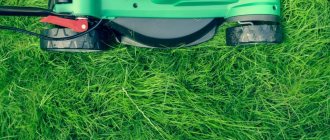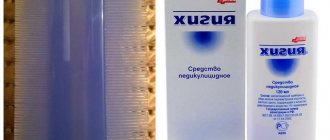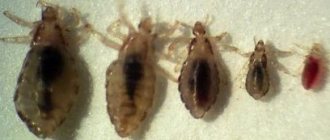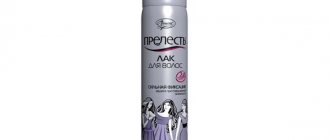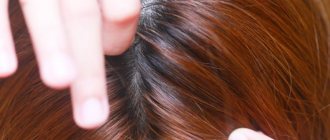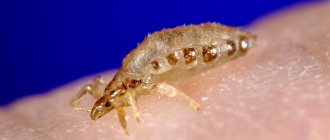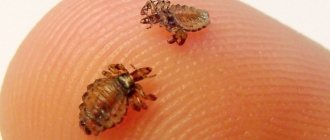Symptoms of linen lice
The presence of parasites can only be determined by bites on the body. Insects feed on blood and eat in most cases at night, when a person is in bed. The process of food absorption lasts up to 3 minutes, the frequency of bites is several times a week. Linen lice, unlike head lice, do not live on the body; they crawl there only to feed. If there is no food source for 7 days, the insects die.
The parasite injects a special substance that prevents blood clotting. With frequent bites, an allergic reaction and inflammation develop. When scratching, an infection gets into the wound and ulcers appear. Therefore, the symptoms of linen lice on the skin depend on the stage of infection and the number of parasites.
Insects settle in linen, mattresses, and underwear. In places where the power source is closest. Externally they resemble a head louse. The body size of an adult is up to 5 mm, the body is translucent. Elastic chitinous cover, capable of stretching. Nits are white, oblong in shape, up to 2 mm. Lice lay eggs in linen, bedding, and folds of clothing.
What do body lice look like?
Body lice (species - pediculus humanus) are specific insects that parasitize exclusively on the human body. They are perfectly adapted to living in the folds of clothing, since the structure of their paws is somewhat different from that of their hairy counterparts. They simply cannot stay on the hair.
The parasite looks like a small bug - its body size does not exceed 4 mm. The color is whitish or grayish-yellow. It feeds exclusively on human blood. Feature - they cannot exist without an “owner”. They prefer to live on wool and cotton fabrics, avoiding silk and satin.
The life cycle is represented by three stages - egg, nymph, adult. On average, the complete development of the parasite - from the nit stage to sexual maturity - takes no more than 16 days (subject to the creation of an optimal temperature regime). The transformation occurs through triple molting.
The life of an adult lasts 1.5...2 months. During this time, one female manages to lay about 400 eggs. This is a lot, and therefore lice reproduce very actively.
How to detect a parasite? There are certain symptoms and signs, but the most striking is the presence of itchy bite marks that heal on the third or fourth day from the moment of appearance. When piercing the skin, pediculus humanus introduces a special enzyme into the human blood: it prevents blood clotting, but causes severe itching. Bites always appear on “bare” skin - the scalp, pubis and armpits are not affected. In the photo you see an advanced case of linen lice.
What is the difference between a body louse and a head louse? There are several of them:
- The first difference is the habitat. Linenworms live only on human clothing, preferring to hide in its folds. Head and pubic - in the hairline: the first on the hair of the head, the second - on the pubis;
- the second difference is color. Clothes are distinguished by a yellowish-white color. Head and pubic bugs can look like brown, gray and yellowish bugs, successfully camouflaging themselves with the tone of the “owner’s” hair, and therefore are often hardly noticeable on his head;
- the third difference is resistance to cold. Body lice are distinguished from their head lice by their resistance to freezing.
Linen lice bites on the body, photo
Single bites are no different from a midge, mosquito, or bed bug. At the site of saliva injection, slight swelling and redness appear, and itching appears over time. There is a dark spot of dried blood in the center.
Currently reading: Nervous lice - can they appear?
With severe infection, there are many spots, they are located chaotically, often merge into one huge spot or look like a rash. Insects bite in areas where blood vessels are located closer to the surface - legs, shoulders, back, arms, neck. Less often the stomach. Adults are not bitten on the head; in children, bites are found on the face. Parasites do not live in the scalp.
Features of the lifestyle of body lice
The habits of pests began to change ever since people started using clothing to protect their bodies. Parasites adapted to this and evolved. The lifestyles of body lice and head lice are similar. The main difference lies in the habitat. The difference in the anatomy of the paws does not allow body pests to live in the hair.
Where do they live?
The louse hides in folds, seams, and folds of fabrics. The inside of clothes and pockets become their favorite habitat. Insects try to settle as close to the host's body as possible. They are most attracted to the following surfaces:
- natural (cotton) fabrics;
- woolen fabrics;
- stale linen.
Body lice cannot move on smooth synthetic fabrics. Parasites do not live on the following tissues:
- silk;
- satin;
- shiny.
How they eat
Body lice are typical hematophages, which literally means “blood eaters.” The only food for the insect is human blood. The louse feeds about 3-4 times a day. For this reason, she tries to settle as close to the human body as possible in order to have access to blood. The constant need for food forces insects to parasitize on the body of people who rarely or never change clothes. If the item hangs in the closet for 4-5 days, the louse will die of starvation.
To bite, clothes insects immerse their heads into folds of skin. After being saturated with blood, their appearance changes. The abdomen swells and becomes darker in color. Visually, in the photo, the parasite can be confused with an ordinary flea. The main difference is that lice cannot jump and do not stay in groups. If after being bitten the insects crawl away, then they are definitely not fleas.
How do they reproduce?
Linen lice breed only on clothing. Hard-to-reach places provide safety for nits; after emerging from the eggs, the larvae begin to live as adults. The ideal temperature for the reproduction of the clothes parasite is 30-33 °C. When it drops to 15 °C, the development of nits stops. At temperatures below -13 °C or above 60 °C, adult lice die. Knowledge of such biological characteristics is useful when getting rid of pests in a non-chemical way.
Body lice are considered insects with an incomplete transformation cycle. With a favorable microclimate, they develop in 2-3 weeks. The parasite goes through the following stages:
- Egg – the initial stage of development lasts from 5 days to several weeks. The higher the ambient temperature, the faster the transformation occurs. At temperatures below 22 °C, embryo development stops.
- Nymph is the larval stage. During this period, the larvae molt three times. The first molt lasts 3-5 days, the second – 5 days, the third – 4 days.
- Imago (adult louse) – reproductive stage. Under favorable conditions, lasts about 30 days. During this period, females lay several eggs daily.
How are they transferred?
Body lice have wings to move between hosts; body lice do not have them. Pediculosis is transmitted through close contact of an infected person with a healthy person. The contact should be long-lasting, because the speed of movement of the insect is about 20 cm per minute. Another option is to use the clothing of a person who is a carrier of the disease. Parasites can live in water for about 48 hours. Favorable conditions for infection:
- public transport;
- public reservoirs, baths, saunas, swimming pools;
- kindergartens, camps, schools, hospitals and other crowded places;
- hiking trips;
- sharing clothes or linen;
- trying on clothes, especially second-hand ones.
What body lice bites look like on the body, photo
Lice that live in things, bedding, and clothing have several names - linen lice, body lice, clothing lice, clothing lice. Nests are formed by insects in folds of fabric, blankets, mattresses, and underwear, but there is no difference between these parasites.
The symptoms are similar. Infection can occur at any time of the year, therefore, if itchy spots or swellings are detected, it is necessary to examine the head and bed.
Home (folk) remedies for body lice
Aimed at treating the body with repellent compounds, disinfecting bed linen and using repellent plants.
Tansy
A plant hated by all insects and ectoparasites. Bunches of tansy hung near the bed will get rid of bed bugs, lice, spiders and cockroaches. Decoctions and infusions are used to rinse the body to prevent bed lice attacks.
Tea tree oil
Used to lubricate bite sites and diluted (3-4 drops per liter of water) for rinsing and washing.
Concentrated cranberry juice
The composition is applied to the bitten areas. If desired, you can dilute it with water 1:3 (one part cranberry juice) and rinse your body.
Disease prevention and prognosis
Regular body hygiene is considered the best method of prevention. It’s hard to argue with this, but a clean body is no less appetizing to body lice than a dirty one.
It will be more effective to timely wash all clothes and heat treat the outer ones to destroy the parasites hiding in the folds.
In order for the forecast to be favorable, it is recommended to avoid crowded places, not to use other people’s things, and to thoroughly wash items purchased at spontaneous markets and second-hand stores.
Linen bug bites, photo
Insects do not live in the wild; they live only in human habitation. Infection can occur at any time of the year. They get into the house with infected things or from neighbors through cracks in the wall, floor, sockets, wiring, ventilation shafts. They differ in appearance from linen fleas, but their lifestyle is similar.
Bedbugs settle closer to the sleeping area, but do not necessarily settle in the bed. These can be sockets, books, interior items, wallpaper, household appliances, and much more. They crawl out of their shelters at night and attack a sleeping person. Bites appear on the neck, shoulders, arms, back, legs. They often bite in open areas.
Adults feed once every 10 days, nymphs of different ages feed every 3 days. During the bite, a substance is injected that prevents blood clotting. Adult bedbugs contain pain-relieving components in their saliva, so people do not hear the bite itself. Symptoms appear in the morning.
Bed bugs pierce the skin in a certain sequence - 2 bites in the form of a path. There is inflammation, swelling, redness, and dried blood in the center. With severe infection, large spots and allergies form.
What kind of parasite is a body louse?
Lice are divided into 3 types:
- pubic;
- head;
- wardrobe
What all types of lice have in common is rapid reproduction. At the same time, they create discomfort for the infected person and are carriers of infections.
The linen louse is small in size with a thickening in the center of the body. The length of an adult is 3-5 mm . The color is light gray or light yellow. There are no wings - this prevents them from moving long distances. The larvae of linen or body lice resemble adult individuals, only of a miniature size of 1-2 mm. Full development occurs after 3 moults have passed.
The optimal reproduction process occurs at high temperatures up to 30˚ C. Low temperatures (15˚ C) have a negative effect on reproduction and growth. The killing temperature for insects is plus 60˚ C and below minus 13.
The lifespan of males is up to 30 days. Whereas females exist for 45 days. During this period, one female lays 140 nits . As soon as the larvae emerge from the egg, they begin to suck blood once a day. At the same time, the first molt occurs, the second - after 5 days, the third - after 8.
The complete growth cycle from egg to subsequent reproduction is 16 days. The process of reproduction is repeated again. Two months are enough to increase the size of the colony several hundred times . Therefore, it is necessary to begin the fight against parasites in a timely manner.
Photo
Linen flea bites
Small jumping creatures do not live in linen or clothes. They prefer to live under the floor, baseboards, in carpets, near the pet's sleeping place. The flea is dark, almost black in color, jumps well, and bites painfully. It begins to attack in the evening. Bites exposed areas of the body. Often the legs suffer. You can feel the bite immediately, since there is no anesthetic component in the saliva of insects. Redness, a dark spot with dried blood, and severe itching immediately appear. Swelling occurs with multiple bites. They parasitize mainly in the warm season; there are no fleas in winter. They don’t sneak into a sleeping person’s bed.
Currently reading: Incubation period of lice and nits - when to expect replenishment
Destruction of linen lice
Requires general cleaning and mass washing.
- The clothes that the person wore for a month before the bites appeared and if they are present are thrown into the wash, and the bedding is boiled. They wash things at 90 degrees Celsius. Dry outside, iron with steam.
- A person needs to take a shower and choose a means to treat bites. Single spots go away on their own within a week; massive bites require therapy.
- It is recommended to dry clean the mattress or treat it with an insecticidal agent, and after 2 hours take it out into the fresh air for ventilation.
- The house should be disinfested or thoroughly cleaned using special solutions to repel parasites. Linen lice do not live in carpets and soft toys.
If no bites appear on the body within 2 weeks, the operation to destroy parasites can be considered successful. If at least one bite occurs, washing the linen and bedding must be repeated.
Lice spray
There are no special means. Insecticidal aerosols and broad-spectrum sprays are used. Disinsection is carried out throughout the house if the room is heavily infested, or the bed, sofa on which the person slept, or mattress are treated.
The treatment procedure is simple - spray the poison at a distance of 20 cm from the surface and leave for 2 hours. The furniture is wiped with a solution of baking soda and salt to completely neutralize the effect of the insecticide. The mattress should be well aired.
If disinfestation is carried out throughout the apartment, leave the room closed for 2 hours, then carry out general cleaning and ventilate well. To combat linen lice, it is not necessary to use powerful insecticides; you can use any insect repellent aerosol with a wide spectrum of action:
- Raptor;
- Raid;
- Clean house;
- Dichlorvos;
- Karbofos.
You should work in a respirator and rubber gloves. If the product is used incorrectly, poisoning of varying degrees of severity occurs.
Currently reading: Lice on hair (photo) – in dreams and in reality
How to get rid of body lice at home?
In the case of linen parasites, it will take much more time than with head seams. Here you won’t limit yourself to just washing your hair with chemicals.
Algorithm of actions:
- take a bath with hot water;
- use tar soap for the body and for foam in the bath;
- stay in the hottest water for 15 minutes;
- Treat bite wounds with any alcohol lotion;
- bed linen and cotton clothes are washed at high temperatures with the addition of Permethrin or Karbofos. Permethrin is also used to get rid of scabies mites. How to cure scabies and what medications are used, see here.
- then dried, ironed on both sides;
- Dry blankets and mattresses in the sun or place them in plastic bags for several days and spray the chemical inside;
- Carefully iron clothes on both sides, pay attention to seams, collars, pockets, where they are most likely to be found;
- treat carpets and rugs with chemicals and ventilate them;
- wash the floors in the room with chemicals, since insects under good conditions can survive and crawl back onto clothes.
Garment processing
All clothing is subject to heat treatment:
- Wash cotton clothes in a machine, and the temperature should be maximum;
- dry in the sun and iron on both sides. The sun's rays will kill not only lice, but also their larvae;
Treat items not intended for high-temperature washing:
- in dry cleaning or at home with insecticides;
- ferry. To do this, switch the iron regulator to the “steaming” mode and run it over outerwear, fur hats and fur coats;
- in the freezer, in the cold. After freezing, dry in the sun.
- prepare the mixture: twenty percent soap, kerosene. Leave items in the solution for 20 minutes, then wash in cool water. One caveat, the smell does not dissipate well;
Remedies for body lice
Chemicals are used for things that are not intended to be processed at high temperatures and are large (mattresses, blankets, rugs, bedspreads).
So, you can use the following tools:
- Medifox product.
- drug "A-PAR";
- "Pedilin";
- "NOK";
- Pyrethrum powder is added to a sealed package with laundry for 2 hours;
- "Lauri";
- "Veda-2";
- "Buzzed."
After treatment, clothes and large items are ventilated and dried.
Folk remedies:
- the fern houseplant repels bloodsuckers;
- tansy, vinegar - added to water when rinsing, after processing;
- cranberry juice to remove nits;
- Euphorbia - placed in closets with clothes.
Treatment of bites
At the initial stage of infection with pediculosis, you can use folk remedies, pharmaceutical drugs with antipruritic, anti-inflammatory properties. If an allergic reaction develops, antihistamine ointments and lotions are used. If the wounds become infected and ulcers form, local antibiotics are used.
Folk remedies for linen lice bites:
First aid supplies:
Antihistamines, antiallergic drugs:
Local antibiotics:
If the condition does not return to normal within 3 days, you should seek help from specialists.
